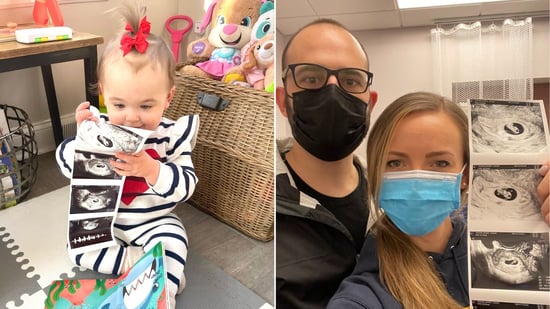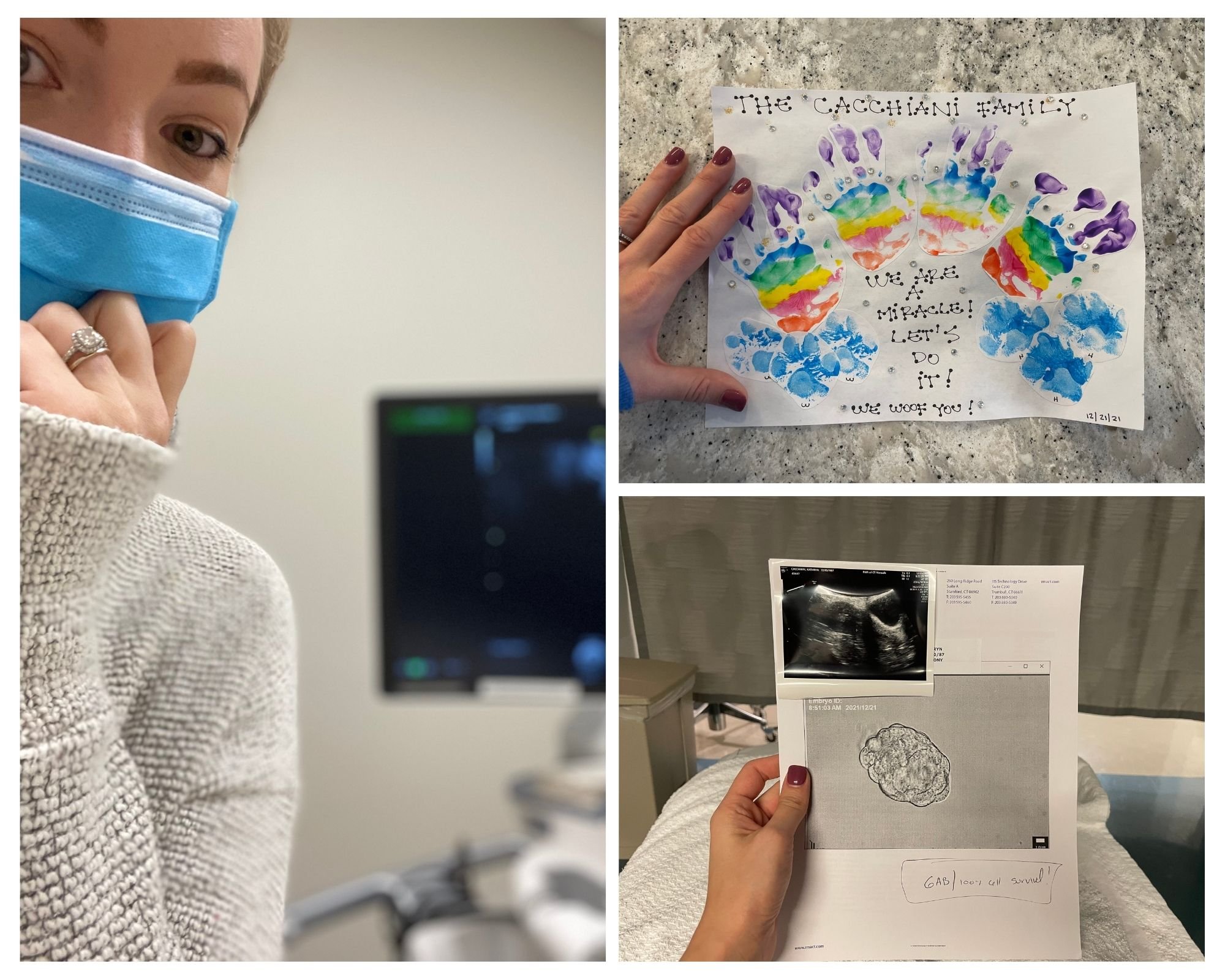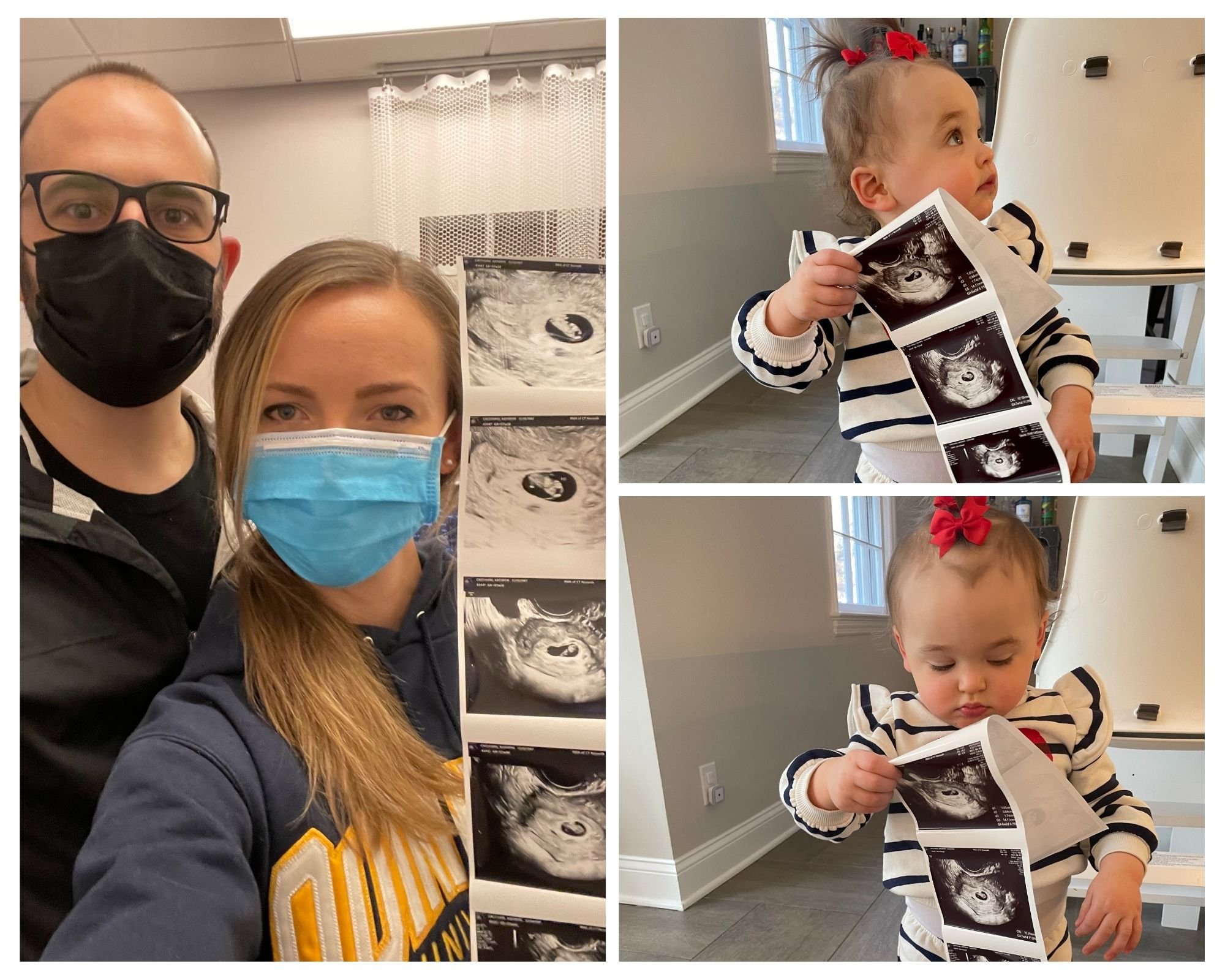Katie's Story, Part 2: The Road to Baby #2
January 28th, 2022 | 11 min. read

This is Part 2 of our Katie's Story series. Read Part 1 and Part 3.
After a long journey involving multiple pregnancy losses, three rounds of IVF and lots of waiting, we finally welcomed our daughter Nora in 2020. But we were anxious about what it would take for us to try and give Nora a little brother or sister. This is Part 2 of my story, which includes some updates about whether our fourth frozen embryo transfer was successful, the emotional roller coaster of early pregnancy and what's next for our family.
Skip to a specific section:
- July 2021: Planning for Baby #2
- Navigating Insurance & the Emotions of Starting Again
- My Second Egg Retrieval
- December 2021: Frozen Embryo Transfer
- January 2022: Am I Pregnant?
- Pregnancy Ultrasound #1
- Pregnancy Ultrasound #2
- Where Am I Now?
- More Infertility Resources
From Katie's Story (Part 1): Since my Nora was our last frozen embryo, we knew that we were going to need to do another egg retrieval and embryo freezing cycle in preparation for Baby #2. Knowing how many embryos we needed and how long it took for us to have our first child, we were proactive since we didn’t want to waste too much time before freezing more embryos…
July 2021: Planning for Baby #2
Nora was our last frozen embryo, so we knew we’d need to do another egg retrieval and embryo freezing cycle to prepare for our next round of IVF. We had a consultation with Dr. Hurwitz to make a plan.
It had only been nine months since we had Nora, but wanted to be proactive about preparing for Baby #2, especially considering that our journey to Baby #1 took over 2 1/2 years, two miscarriages, two hysteroscopies, an ERA cycle and a total of three FET cycles (one miscarriage, one failed transfer) to finally welcome our rainbow baby.
We hoped we wouldn’t have to go through all this again, and we'd have an easier, more “normal” journey to Baby #2. But we knew our chances of that happening were slim, so we didn’t want to waste much time - especially knowing we didn’t have any embryos left.
Navigating Insurance & the Emotions of Starting Again
Dr. Hurwitz recommended we wait to do a transfer until one year after childbirth, but that didn’t mean we couldn’t proceed with an egg retrieval and do one frozen embryo transfer (FET) before the end of year. The reason for this was mainly due to our insurance policy, which covers two rounds of IVF per year, so it was important to us that we do a transfer before the 2021 insurance cycle ends, so we could do two transfers in 2022 if we needed to.
➡️ Related: Will Insurance Cover My Fertility Treatment?
It took three FETs to have our first child, so there was definitely the chance of it taking three (or more) this time as well. The thought of planning ahead for multiple IVF rounds was overwhelming and disheartening, and I really didn’t know how much more I could take on.
It was hard enough going through the physical, mental and emotional strains of fertility treatment with a full-time job in the midst of a global pandemic, but now I also had a 9-month old baby who I wanted to fully enjoy, and be “on” for 24/7. I was so tired of being “brave” and all the ups and downs of fertility treatments.
My Second Egg Retrieval
This time, going into egg retrieval, I felt numb to everything. I was not the same person I was back in 2018 when I did my first egg retrieval. I just wanted and needed to go through the motions, take it one day at a time, accept the side effects, constant blood draws, injections, and medications because I wanted most of my main focus to remain on Nora, who I waited so long for, and who I adore more than anyone or anything in the world.
I was stunned when I woke up in the recovery room after my egg retrieval to learn that 23 oocytes/eggs were retrieved that day. I was expecting less than 10, since my first retrieval in 2018 had produced 11 eggs.
In the days that followed, my wonderful nurse kept me updated on how many eggs fertilized, then made it to the blastocyst stage before our embryos were PGT-A tested, then frozen. Four embryos ended up being sent to the lab for genetic testing, and when the results were in, we had one abnormal embryo, one mosaic embryo, and two genetically “normal” embryos.
➡️ Related: IVF Attrition Rate: Why Don’t All Eggs Create Embryos?
It’s truly fascinating, yet disappointing, that the attrition rate is so high - to start with 23 eggs, and by the end of testing, have only two normal embryos, is frustrating.

December 2021: Frozen Embryo Transfer
The break I had between my egg retrieval and frozen embryo transfer (FET) was really helpful. I was able to push fertility treatments to the back of my mind knowing we had two healthy embabies waiting for us.
I started a new job here at Illume Fertility (which I absolutely love), celebrated my daughter’s first steps, her first birthday, and had a stress-free(ish) holiday season, even though I had started my FET protocol medications to prepare for a late December 2021 transfer.
💡What is an "embaby?" This is a term used by many fertility patients to lovingly refer to their frozen embryos, or little "embryo babies." For many parents-to-be, being able to refer to their embryos in this more personal way provides a sense of hope and emotional connection.
When FET day came, once again I felt pretty numb - like it was just a routine appointment. I would be remiss to say I didn’t feel moments of panic though. I had laser acupuncture scheduled with Dr. Amy Matton scheduled before and after my embryo transfer to help calm my nerves and increase blood flow.
I highly recommend acupuncture pre and post-transfer! The fertility acupuncturists at Illume Fertility are amazing, caring, supportive partners to have on transfer day.
Learn more about laser acupuncture:
I knew exactly what to expect during the transfer. This was my fourth one with Dr. Hurwitz, and it was comforting to know the “routine” and have my primary doctor (who I had known for over three years) do the procedure.
➡️ Related: 6 Things Everyone Wonders About Embryo Transfer
My husband held my hand through the whole transfer as we watched the embryo being placed into my uterus like magic. And just like that, the transfer was complete, and now I had to endure the dreaded 10-day wait (not the usual two-week wait since we transferred a Day 5 embryo).
Luckily, the waiting time overlapped with Christmas and New Year's, so I was distracted - to an extent. Let’s be honest, of course I was symptom-checking, had sleepless nights, and spiraled into the “what ifs” that left me so overwhelmed to the point I was locking myself in the bathroom, crying on the floor, hoping Nora didn’t see or hear me in this state.
Infertility trauma, paired with hormone medication and lack of sleep, is really really hard.
January 2022: Am I Pregnant?
Beta Day & HCG Levels
I had my first HCG blood test in early January 2022. I went into the Illume Fertility office early one morning for a blood draw.
I would hear back by that afternoon what my results were. I had tested early at home (which is NOT recommended, but I couldn’t help myself knowing I had a stash of cheap value pack pregnancy tests hidden away), and got a positive at home - two little lines. But I still wasn’t convinced I was pregnant - I needed the HCG level number to confirm.
My primary nurse, who has always been so great delivering me both good and bad news, called me, and as soon as I picked up the phone, I heard the words I was hoping for: “Katie, you’re pregnant!” My HCG was at 106, which is a good number, considering they look for levels over 50.
Four days later, I had my second HCG blood test to ensure my HCG levels were rising as they should. I was relieved to hear they had risen to 766.
➡️ Related: Watch Katie's Instagram Lives & Video Updates
Pregnancy Ultrasound #1
After these two HCG blood tests, I was scheduled for my first pregnancy scan about a week later. The nerves kicked in on that day. I now felt attached to this pregnancy, even though I tried so hard not to get my hopes up.
With PGT-A testing embryos, you can also choose to know the gender/s ahead of transfer, so my husband and I already knew the gender of our embryo and had a name chosen. Was I setting myself up for another disappointment? Would this round actually be successful?
Dr. Hurwitz could tell I was nervous about this scan. I was not even six weeks pregnant yet, so he prepped me ahead of the ultrasound, reminding me that we might or might not see the flicker of a heartbeat during this scan. If we did, great! If we didn’t, it doesn’t mean anything significant at that point.
I took my husband’s hand and held it tight as Dr. Hurwitz performed the ultrasound. There was the gestational sac, yolk sac, and fetal pole. And then, a tiny flickering heartbeat. Relief washed over me as I felt tears fill my eyes.
It was still so early in my pregnancy that I knew a miscarriage could still happen. Both of my miscarriages happened after six weeks, so that feeling of relief was temporary. Nevertheless, I had reached another milestone. And now came more waiting - this time, for my next pregnancy scan at seven weeks.
Pregnancy after a loss can be hard. Read more:
All this time, I was still taking five tabs of Estrace (estrogen) a day, and a progesterone injection each morning. Every time I took my meds, I told myself “This is helping me stay pregnant. Trust the process.”
The side effects of these medications and side effects of just being pregnant started to really kick in. Hot flashes overnight, fatigue, sporadic dull cramping, and bouts of nausea were part of my everyday life. Every symptom I felt I would wonder “Is this from the meds?” “Is this a first trimester symptom?” “Could this be a sign of miscarriage?”
Pregnancy Ultrasound #2
This was the ultrasound I was the most nervous for. During my first embryo transfer, I found out I miscarried at this appointment, and was told there was no longer a beating heart. It was a complete shock – I had no concerning symptoms leading up to that scan, and I recall the utter devastation and heartbreak I felt.
I broke down in the exam room. I could barely talk, let alone fathom another pregnancy loss, especially after all the fertility testing, medications, injections, appointments, and embryo testing I had to go through.
Dr. Hurwitz and my husband knew this was the scan I was most worried about. Despite all their positive reinforcement, I still couldn’t get myself to think positively. I had no concerning symptoms this time - just like when I miscarried last time.
I held my breath and closed my eyes as he started the scan. Oh my gosh, it grew! And there were little limbs now! And a beating heart. Dr. Hurwitz could tell I was in disbelief. His excitement and positive attitude finally helped me breathe, smile and let the reality of this good news sink in. Another milestone reached - our embryo was now officially a fetus!
Where Am I Now?
As I write this, I’m now eight weeks pregnant. If all goes well with my next scans, I will graduate from Illume Fertility in a couple weeks, and start going to my regular OB's office. I don’t want to think too far ahead, get too excited or anxious.
Thinking about going cold turkey from my hormonal medications and moving on from being so closely monitored and cared for by my Illume Fertility patient care team is bittersweet. That topic and transition will be saved for my next post.
What happens after you get pregnant?
Thank you to everyone who has been following along with our journey to Baby #2. My husband and I are incredibly grateful for all of the support, love and prayers from you along the way. We’ve met so many fellow infertility warriors through sharing our story, and we know we aren’t alone in the struggle.
We are humbled by the strength, courage and bravery of all who shared their own personal loss and infertility stories with us.
Read Part 1 & Part 3 of our story now!
Follow along on Instagram for more updates.
More Infertility Resources
Katie Cacchiani is Illume Fertility's former Head of Patient Acquisition (and even more importantly, Nora and Carter's mom). Having gone through years of trouble conceiving and IVF treatment, Katie knows how difficult infertility is - firsthand. She combines her skills and experience to help other fertility patients feel empowered and supported on their own journey.



